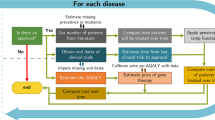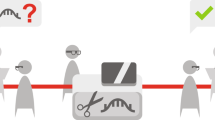Abstract
Gene-based therapies are changing the landscape of medicine for patients with rare diseases. These one-time, potentially curative treatments pose a challenge in the US healthcare model, where high prices and insurance coverage variation may prevent patients from receiving life-altering therapies. Questioning of high prices occurs when patients, payers, and policy makers hold divergent views on the value and uncertainty of therapies. The key for patients is that high prices need to be justified, and companies need to partner authentically with patients. Companies should not automatically assume that the combination of the “gene therapy” label and a small patient population justifies high prices. To speed up the development process and potentially reduce costs, patients want the industry to improve clinical trial efficiency by sharing data, including natural history studies and failed trial results. From the patient perspective, current value assessment frameworks disadvantage people with disabilities, may not accurately reflect patients’ and societal views, and omit necessary factors such as impact on caregivers, lost productivity, and the future value of innovation. Value determination methods need to provide fair incentives and outcomes to industry, payers, regulators, and especially patients—the courageous pioneers who need equitable and sustainable access to life-changing gene-based therapies.
This is a preview of subscription content, access via your institution
Access options
Subscribe to this journal
Receive 12 print issues and online access
$259.00 per year
only $21.58 per issue
Buy this article
- Purchase on Springer Link
- Instant access to full article PDF
Prices may be subject to local taxes which are calculated during checkout


Similar content being viewed by others
References
What is gene therapy? U.S. Food and Drug Administration. https://www.fda.gov/BiologicsBloodVaccines/CellularGeneTherapyProducts/ucm573960.htm. Accessed 1 Apr 2019.
FAQs about rare diseases. Genetic and Rare Diseases Information Center (GARD)—an NCATS Program. https://rarediseases.info.nih.gov/diseases/pages/31/faqs-about-rare-%20diseases. Accessed 18 Mar 2019.
U.S. Department of Health and Human Services, Food and Drug Administration, Center for Biologics Evaluation and Research. Human gene therapy for rare diseases: draft guidance for industry. U.S. Department of Health and Human Services, Food and Drug Administration, Center for Biologics Evaluation and Research; 2018.
RARE facts. Global Genes. https://globalgenes.org/rare-facts/. Accessed 18 Mar 2019.
About rare diseases. EURORDIS–Rare Diseases Europe. https://www.eurordis.org/about-rare-diseases. Accessed 1 Apr 2019.
White W, Calhoun C, Holovach J, Marie J, Buchanan L, Sames M et al. Uncommon challenges: shared journeys: stories of love, hope, and community by rare disease caregivers. Oak Park: Siren Interactive; 2011.
Ali F, Slocomb T, Werner M. Curative regenerative medicines: preparing health care systems for the coming wave. In Vivo, 15 November 2016. https://invivo.pharmaintelligence.informa.com/IV004955/Curative-Regenerative-Medicines-Preparing-Health-Care-Systems-For-The-Coming-Wave. Accessed 18 Mar 2019.
University of Pennsylvania School of Medicine. New payment model for gene therapy needed, experts say. ScienceDaily, 9 September 2014. https://www.sciencedaily.com/releases/2014/09/140909192126.htm. Accessed 1 Apr 2019.
Jørgensen J, Kefalas P. Annuity payments can increase patient access to innovative cell and gene therapies under England’s net budget impact test. J Mark Access Health Policy. 2017;5:1355203.
Danzon PM. Affordability challenges to value-based pricing: mass diseases, orphan diseases, and cures. Value Health. 2018;21:252–7.
Carr DR, Bradshaw SE. Gene therapies: the challenge of super-high-cost treatments and how to pay for them. Regen Med. 2016;11:381–93.
Shire. Rare Disease Impact Report: Insights from Patients and the Medical Community. Shire; April 2013. https://globalgenes.org/wp-content/uploads/2013/04/ShireReport-1.pdf. Accessed 1 Apr 2019.
EURORDIS–Rare Diseases Europe. Breaking the Access Deadlock to Leave No One Behind. EURORDIS–Rare Diseases Europe. https://www.eurordis.org/content/breaking-access-deadlock-leave-no-one-behind. Accessed 18th Mar 2019.
Garrison LP, Jackson T, Paul D, Kenston M. Value-based pricing for emerging gene therapies: the economic case for a higher cost-effectiveness threshold. J Manag Care Spec Pharm. 2019. https://doi.org/10.18553/jmcp.2019.18378. epub ahead of print 20 February 2019
Boon W, Broekgaarden R. The role of patient advocacy organisations in neuromuscular disease R&D—the case of the Dutch neuromuscular disease association VSN. Neuromuscul Disord. 2010;20:148–51.
Lowe MM, Blaser DA, Cone L, Arcona S, Ko J, Sasane R, et al. Increasing patient involvement in drug development. Value Health. 2016;19:869–78.
Morel T. Rare diseases and orphan drugs: patient values, market trends and misconceptions. Belgium: Doctoral dissertation, KU Leuven, 2019.
Salzman R, Cook F, Hunt T, Malech HL, Reilly P, Foss-Campbell B, et al. Addressing the value of gene therapy and enhancing patient access to transformative treatments. Mol Ther. 2018;26:2717–26.
Centers for Medicare & Medicaid Services. Who are the MACs. Centers for Medicare & Medicaid Services. https://www.cms.gov/Medicare/Medicare-Contracting/Medicare-Administrative-Contractors/Who-are-the-MACs.html. Accessed 1 Apr 2019.
Dorros G. FDA approval does not mean what you think it does!. Hudson Institute; 19 August 2010. http://www.hudson.org/research/7264-fda-approval-does-not-mean-what-you-think-it-does-. Accessed 18th Mar 2019.
Radke J. Insurance companies limit coverage for approved SMA drug. Rare Disease Report. https://www.raredr.com/news/insurance-sma-drug. Accessed 19 Mar 2019.
National Alliance for Caregiving and Global Genes. Rare disease caregiving in America. National Alliance for Caregiving and Global Genes; 2018. https://www.caregiving.org/wp-content/uploads/2018/02/NAC-RareDiseaseReport_February-2018_WEB.pdf. Accessed 1 Apr 2019.
Raymond N. Alexion reaches $13 million deal in U.S. drug charity kickback probe. Reuters; 7 February 2019. https://www.reuters.com/article/health-alexion/alexion-reaches-13-million-deal-in-u-s-drug-charity-kickback-probe-idUSL1N202206. Accessed 1 Apr 2019.
Thomas Z. Swift T ‘The most hated man in America’? BBC News; 4 August 2017. https://www.bbc.com/news/world-us-canada-34331761. Accessed 18 Mar 2019.
Rapaport L. Another look at the surge in EpiPen costs. Reuters; 27 March 2017. https://www.reuters.com/article/us-health-epipen-costs-idUSKBN16Y24O. Accessed 18 Mar 2019.
CNBC. Marathon charges $89,000 a year for new muscular dystrophy drug. CNBC; 13 February 2017. https://www.cnbc.com/2017/02/13/marathon-charges-89000-a-year-for-new-new-muscular-dystrophy-drug.html. Accessed 18 Mar 2019.
Keown A. Price of Teva’s generic drug to treat Wilson’s disease sparks outrage. BioSpace; 26 February 2018. https://www.biospace.com/article/price-of-teva-s-generic-drug-to-treat-wilson-s-disease-sparks-outrage/. Accessed 18 Mar 2019.
Martin C. Pharma should take a tip from the chemical industry to stem the outrage over drug pricing. Stat; 10 May 2018. https://www.statnews.com/2018/05/10/pharma-chemical-industry-drug-pricing-outrage/. Accessed 18 Mar 2019.
Morel T, Aymé S, Cassiman D, Simoens S, Morgan M, Vandebroek M. Quantifying benefit-risk preferences for new medicines in rare disease patients and caregivers. Orphanet J Rare Dis. 2016;11:70.
Burton-Chase AM, Parker WM, Hennig K, Sisson F, Bruzzone LL. The use of social media to recruit participants with rare conditions: Lynch syndrome as an example. JMIR Res Protoc. 2017;6:e12.
Child Neurology Foundation and Global Genes. Rare Access to Critical Therapies (ACT) Stakeholder Summit: Summary Report. Child Neurology Foundation and Global Genes; 5 October 2018.
Levitan B, Getz K, Eisenstein EL, Goldberg M, Harker M, Hesterlee S, et al. Assessing the financial value of patient engagement: a quantitative approach from CTTI’s Patient Groups and Clinical Trials Project. Ther Innov Regul Sci. 2018;52:220–9.
U.S. Food and Drug Administration. About orphan products natural history grants. U.S. Food and Drug Administration. https://www.fda.gov/ForIndustry/DevelopingProductsforRareDiseasesConditions/OrphanProductsNaturalHistoryGrantsProgram/ucm487336.htm. Accessed 20 Mar 2019.
IQVIA Institute. Orphan Drugs in the United States: growth trends in rare disease treatments. Parsippany, New Jersey: IQVIA Institute; October 2018. https://www.iqvia.com/institute/reports/orphan-drugs-in-the-united-states-growth-trends-in-rare-disease-treatments. Accessed 1 Apr 2019.
QuintilesIMS. Orphan Drugs in the United States: Providing Context for Use and Cost. QuintilesIMS; October 2017. https://rarediseases.org/wp-content/uploads/2017/10/Orphan-Drugs-in-the-United-States-Report-Web_-Update1018.pdf. Accessed 1 Apr 2019.
Ventola CL. The antibiotic resistance crisis. Pharm Ther. 2015;40:277–83.
Sargent B, Glover C, Jaluria P, Madsen J, Moore A, Tredenick TL. Key considerations for gene therapy commercialization. Cell Culture Dish; 12 September 2018. https://cellculturedish.com/key-considerations-for-gene-therapy-commercialization/. Accessed 20 Mar 2019.
Paulden M, Stafinski T, Menon D, McCabe C. Value-based reimbursement decisions for orphan drugs: a scoping review and decision framework. PharmacoEconomics. 2015;33:255–69.
Smith WS. Key Questions for Legislators about the Institute of Clinical and Economic Review (ICER). Pioneer Health White Paper No. 189. Boston: Pioneer Institute; January 2019.
Dranove D. What’s Your Life Worth? Health Care Rationing… Who Lives? Who Dies? And Who Decides? Upper Saddle River: FT Prentice Hall; 2003.
Da P, Raza S, Naughton B, Roscoe A, Ramakrishnan A, Ali A, et al. The limitations of QALY: a literature review. J Stem Cell Res Ther. 2016;6:4.
Kelly C. Price ‘anchoring’? Zolgensma and the art of managing gene therapy sticker shock. Pink Sheet; 19 March 2019. https://pink.pharmaintelligence.informa.com/PS124953/Price-Anchoring-Zolgensma-And-The-Art-Of-Managing-Gene-Therapy-Sticker-Shock. Accessed 1 Apr 2019.
Towse A, Garau M. Appraising ultra-orphan drugs: is cost-per-qaly appropriate? a review of the evidence. London: Office of Health Economics Consulting Report; March 2018. https://www.ohe.org/publications/appraising-ultra-orphan-drugs-cost-qaly-appropriate-review-evidence#. Accessed 12 Mar 2019.
Nord E, Daniels N, Kamlet M. QALYs: some challenges. Value Health. 2009;12:S10–S15.
Institute for Clinical and Economic Review (ICER). Patient participation guide. Institute for clinical and economic review (ICER). https://icer-review.org/patient-participation-guide/. Accessed 1 Apr 2019.
Neumann PJ, Willke RJ, Garrison LP Jr. A health economics approach to US value assessment frameworks—introduction: an ISPOR special task force report [1]. Value Health. 2018;21:119–23.
Institute for Clinical and Economic Review (ICER). Spinraza® and Zolgensma® for Spinal Muscular Atrophy: Effectiveness and Value. Institute for Clinical and Economic Review (ICER); 22 February 2019. https://icer-review.org/wp-content/uploads/2018/07/ICER_SMA_Evidence_Report_022219.pdf. Accessed 1 Apr 2019.
The Value Initiative. https://valueinitiative.com/. Accessed 1 Apr 2019.
Patient-Driven Values in Healthcare Evaluation (PAVE). https://www.pharmacy.umaryland.edu/centers/patient-driven-values-healthcare-evaluation-pave/. Accessed 1 Apr 2019.
Lewis C, Abrams MK, Schneider EC, Shah T. Coping with serious illness in America: relying on family and friends. Commonwealth Fund, 2019. http://features.commonwealthfund.org/coping-with-serious-illness-in-america. Accessed 18 Mar 2019.
White W. Rare is different: innovation happens at the margins. Pharmaphorum; 3 April 2012. https://pharmaphorum.com/views-and-analysis/rare_is_different_innovation_happens_at_the_margins/. Accessed 18 Mar 2019.
Carette JE, Raaben M, Wong AC, Herbert AS, Obernosterer G, Mulherkar N, et al. Ebola virus entry requires the cholesterol transporter Niemann–Pick C1. Nature. 2011;477:340–3.
Kittaka M, Mayahara K, Mukai T, Yoshimoto T, Yoshitaka T, Gorski JP, et al. Cherubism mice also deficient in c-Fos exhibit inflammatory bone destruction executed by macrophages that express MMP14 despite the absence of TRAP+ osteoclasts. J Bone Miner Res. 2018;33:167–81.
Tarnowski J, Krishna D, Jespers L, Ketkar A, Haddock R, Imrie J, et al. Delivering advanced therapies: the big pharma approach. Gene Ther. 2017;24:593–8.
Lakdawalla DN, Doshi JA, Garrison LP, Phelps CE, Basu A, Danzon PM. Defining elements of value in health care—a health economics approach: an ISPOR Special Task Force Report [3]. Value Health. 2018;21:131–9.
Acknowledgements
The author thanks Carl Erickson, Pat Furlong, Jayne Gershkowitz, Eric Grinstead, Marie Lamont, Doug Paul, Mary Pittman, Ted Slocomb, Beth White, and Alex Wyke for their invaluable contributions, support, and review of this article and Karin Horler for editing an early version of the paper.
Author information
Authors and Affiliations
Corresponding author
Ethics declarations
Conflict of interest
Wendy White has received compensation as a consultant and employee of Vitrisa Therapeutics. She is also a member of TREND community advisory board. She owns small amounts (<1%) of stock in Amicus Therapeutics, Rocket Therapeutics, Abeona Therapeutics, Sangamo Therapeutics, CRISPR Therapeutics. She is currently chair of the board of Global Genes and was previously director-at-large of National Organization for Rare Disorders (NORD). She is also the parent of a child with a rare connective tissue disorder with no available therapy.
Additional information
Publisher’s note Springer Nature remains neutral with regard to jurisdictional claims in published maps and institutional affiliations.
Rights and permissions
About this article
Cite this article
White, W. A rare disease patient/caregiver perspective on fair pricing and access to gene-based therapies. Gene Ther 27, 474–481 (2020). https://doi.org/10.1038/s41434-019-0110-7
Received:
Revised:
Accepted:
Published:
Issue Date:
DOI: https://doi.org/10.1038/s41434-019-0110-7
This article is cited by
-
Better governance starts with better words: why responsible human tissue research demands a change of language
BMC Medical Ethics (2022)
-
A systematic review of moral reasons on orphan drug reimbursement
Orphanet Journal of Rare Diseases (2021)
-
Retinal gene therapy: an eye-opener of the 21st century
Gene Therapy (2021)



